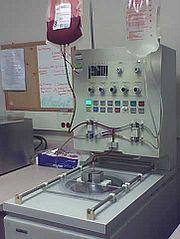
IBM 2991
Encyclopedia

Up until the 1970s, SSD had been at the heart of IBM, for it had produced the millions of punchcards that had been extremely profitable for IBM for more than four decades. By the 1970s business was declining, as IBM's concentration increasingly turned to computing. Accordingly, the vice president in charge of SSD, Everett "Van" Van Hoesen, avidly searched for any new business that could be slotted into SSD. So SSD, an otherwise dying division, became a hotbed of innovation.
Searching for these new products Van started a campaign to win the first (2991) product 'mission', though SSD did not have any significant history of machine production. One key factor, though, was that the products being tendered for also comprised a substantial element of on-going income from the related supplies. In the case of the blood products the annual supplies income could easily run at a rate approaching the capital value of the machine! It was a situation that was familiar to SSD, brought up on the similar philosophy inherent in the punched card business. Van won the mission, probably due to his enthusiasm; and assisted by the fact that the business was much less attractive to other plants.
SSD subsequently added the IBM 2997
IBM 2997
The earliest roots of IBM's development of the IBM 2997 Blood Cell Separator lay in the personal tragedy of one of IBM's development engineers, George Judson. One of his children contracted leukaemia shortly before Judson was due for a sabbatical, funded by IBM, working on a research project of his...
Blood Cell Separator and the IBM 5880
IBM 5880
The IBM 5880, also known as the IBM 5880 Electrocardiograph System, is a computerized electrocardiograph and diagnostic tool. It was developed by IBM scientist Ray Bonner in the early 1970s and announced in 1978....
ECG System to its line of products.

